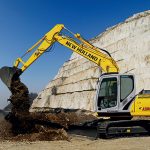Here at MagikMe Equipment, our Consulting Team has heard time and again that modern equipment managers believe one of their toughest decisions (with one of the largest financial impacts) is when they should use an owned asset vs a rented asset.
There are a multitude of factors going into this decision (utilization, time on project, rental policies), but if boiled down to its most basic elements, we believe the most important aspect to consider is utilization, or expected machine hours/meter reads per year. Utilization can then be used to identify the corresponding rental and ownership costs. With that understanding an equipment manager can then easily find the point at which it makes sense to rent or use owned.
We call that the Rental Decision Point™.
For the average Compact Track Loader, we recommend an equipment manager use a rented asset, instead of an owned asset, if they use a machine less than 390 hours per year.
Above, you’ll see a visualization of the Rental Decision PointTM for Compact Track Loaders, 1,751 to 2,200 lbs. To build this graph, we’ve put ownership costs on the Y-axis and meter reads per year on the X-axis. The curve is the ownership costs per hour of an average compact track loader with the assigned meter reads per year.
The min and max of the X-axis represent the distribution of actual machine usage, coming from our proprietary Utilization Database, a custom database available through MagikMe Equipment Consulting. This database was built for both nationwide and 11-regions (increased specificity), and was derived by leveraging the meter reads on machines at the point of transactions. For any model in our database, we show a distribution of machine usage per year (in hours), in 5% increments. In terms of data behind the calculations, for Compact Track Loaders for example, we have tens of thousands of machines in our benchmark.
[su_spacer size=”20″]The blue bar in the middle is the “Rental Rate Zone”, the min and max average hourly rate to rent a piece of equipment, depending on rate type selected. The top bound is the MagikMe Equipment Retail Rental Rate, Daily, divided by eight. The lower bound is the MagikMe Equipment Retail Rental Rate, Monthly, divided by 176 (our standard for assumed machine use per month).
Where do we get our rental data? Through our Retail Rental Partnership Program, we have the most extensive rental data in existence (200+ rental houses), updated quarterly.
How can an MagikMe Equipment user replicate this analysis using their subscription?
To adjust the hourly ownership costs: use the Internal Charge Rate, Bobcat T190 (or any model in size class). Once here, go to “Adjust Costs”, modify the “Annual Use Hours”, click “View Adjusted Hourly Cost” to see how the Ownership Rate has changed. Plug this into your graph.
To determine the monthly and daily retail rental rates: use the Retail Rental Rate, Bobcat T190 (or any model in size class). Once here, look for the respective Monthly and Daily rental rates. By default, the National Rental Rate is displayed. For increased precision, if the location of the rented asset is clear, you can modify the “Region”. Additionally, many Equipment Managers have contractual discounts with rental partners. Using the manual adjustment feature, you can modify the rental rate to reflect any discounting you may receive.
Don’t have access to MagikMe Equipment?
With our Equipment Manager Package, you can replicate the analysis above yourself.
If you are interested in doing this for a large number of machines, contact us at MagikMe Equipment Consulting to find out how we can help do this for you.
[su_spacer size=”10″]





